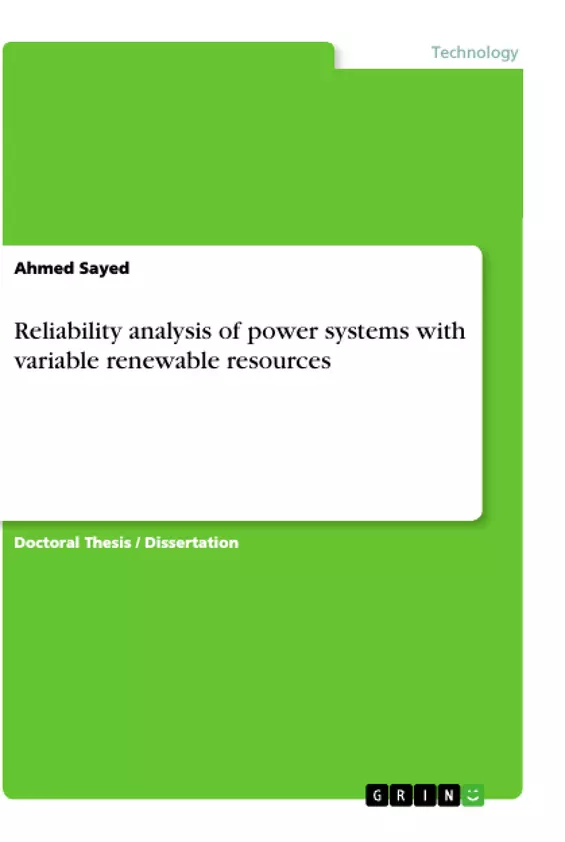This thesis presents a complete reliability, availability, and maintainability (RAM) analysis of the variable renewable energy (VRE) systems. Three operating concepts of the wind energy conversion systems (WECS) are considered based on the acceptable speed range of generators, while seven practical layouts of large-scale grid-connected systems are considered for the solar-PV systems. Elaborated RAM analysis of each system associated with each operating concept for the WECS and each layout of the solar-PV systems is presented starting from the subassemblies level to the subsystem level then the overall system.
This thesis is purposed to describe the method of reliability, availability, and maintainability analysis of repairable and non-repairable systems using the exponential PDFs. It is also aimed to explore the method for improving the availability of these systems by managing the effort using availability importance measures of each subassembly. This analysis will also be utilized to studying the criticality of the subassemblies or subsystems of the system in order to continuous improvement. After doing this, this thesis also extends to look into the overall system availability. This analysis is a good tool for helping to identify the critical subsystems or subassemblies of the system that need more attention for improvement.
Inhaltsverzeichnis (Table of Contents)
- Introduction
- Literature Review
- Reliability analysis of power systems with variable renewable resources
- Reliability modeling and analysis of VRE systems
- Reliability analysis of WECS
- Reliability analysis of solar-PV systems
- Reliability analysis of hybrid VRE systems
- Reliability Modeling and Analysis of VRE Systems
- Reliability analysis of wind energy conversion systems (WECS)
- Reliability analysis of solar photovoltaic (PV) systems
- Reliability analysis of hybrid VRE systems
- Case Studies and Applications
- Conclusions and Future Work
Zielsetzung und Themenschwerpunkte (Objectives and Key Themes)
This thesis aims to provide a comprehensive reliability, availability, and maintainability (RAM) analysis of variable renewable energy (VRE) systems. It investigates the reliability characteristics of wind energy conversion systems (WECS), solar photovoltaic (PV) systems, and hybrid VRE systems. The research explores different operating concepts and system layouts to determine their impact on overall system reliability.
- Reliability assessment of VRE systems
- Impact of variable renewable resources on power system reliability
- Reliability modeling and analysis techniques for VRE systems
- Case studies and applications of reliability analysis in VRE systems
- Future directions in reliability analysis of VRE systems
Zusammenfassung der Kapitel (Chapter Summaries)
The thesis begins with an introduction, outlining the significance of VRE in power systems and the challenges associated with their integration. Chapter 2 provides a comprehensive review of existing literature related to the reliability analysis of power systems with VRE. This chapter focuses on various reliability modeling and analysis techniques for VRE systems, including wind energy conversion systems, solar-PV systems, and hybrid VRE systems. It examines previous studies and their findings on the impact of VRE on power system reliability.
Chapter 3 delves into the reliability modeling and analysis of WECS, considering three operating concepts based on the generator's acceptable speed range. Chapter 4 focuses on the reliability analysis of solar-PV systems, exploring seven practical layouts of large-scale grid-connected systems. Both chapters provide detailed RAM analysis at the subassemblies, subsystem, and overall system levels.
Chapter 5 presents case studies and applications of the reliability analysis techniques developed in the previous chapters. These case studies illustrate the practical implementation of the methods and their impact on the reliability of VRE systems in real-world scenarios.
Schlüsselwörter (Keywords)
The core focus of the thesis is on the reliability analysis of power systems with variable renewable resources. Key terms include: Reliability, Availability, Maintainability (RAM), Variable Renewable Energy (VRE), Wind Energy Conversion Systems (WECS), Solar Photovoltaic (PV) Systems, Hybrid VRE Systems, Reliability Modeling, Reliability Analysis, Operating Concepts, System Layouts, Case Studies, Applications.
- Quote paper
- Doctor Ahmed Sayed (Author), 2020, Reliability analysis of power systems with variable renewable resources, Munich, GRIN Verlag, https://www.grin.com/document/922535



